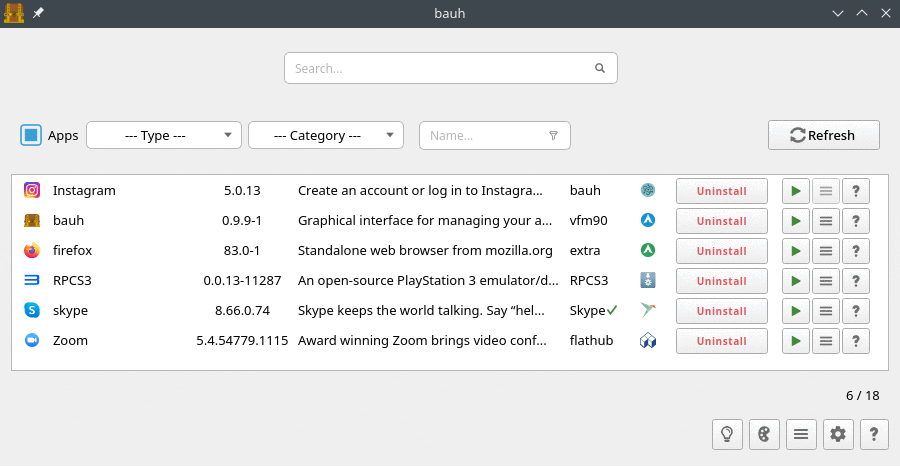How To Install Bauh on Manjaro

In the ever-evolving world of Linux package management, Bauh stands out as a versatile and user-friendly graphical interface for managing software on various distributions, including Manjaro. This comprehensive guide will walk you through the process of installing Bauh on your Manjaro system, helping you harness its power to streamline your software management tasks.
Understanding Bauh and Its Features
Before diving into the installation process, it’s crucial to understand what Bauh is and why it’s becoming increasingly popular among Manjaro users. Bauh, which stands for “Bundle Application User Helper,” is a powerful graphical user interface designed to simplify the management of various package formats on Linux systems.
Key Features of Bauh
Bauh offers a comprehensive set of features that make it an invaluable tool for Manjaro users:
- Multi-format Support: Bauh can handle multiple package formats, including AppImage, Flatpak, Snap, and AUR (Arch User Repository) packages.
- Unified Management Panel: It provides a single interface for searching, installing, uninstalling, and upgrading applications across different package formats.
- Timeshift Integration: Bauh integrates with Timeshift, allowing users to create system backups before making significant changes.
- Customizable Themes: Users can personalize the look and feel of Bauh with various themes.
- Tray Mode: Bauh can run in the system tray, providing quick access to its features without cluttering your desktop.
Advantages of Using Bauh on Manjaro
Manjaro users can benefit significantly from Bauh’s capabilities:
- Simplified Package Management: Bauh consolidates the management of different package types into a single, intuitive interface.
- AUR Integration: It provides an easy way to access and manage packages from the Arch User Repository, which is particularly useful for Manjaro users.
- Reduced Dependency Conflicts: By supporting containerized formats like Flatpak and Snap, Bauh helps minimize potential conflicts between applications and system libraries.
- User-Friendly Interface: Its graphical interface makes it accessible to both novice and experienced Linux users.
Preparing Your System for Installation
Before installing Bauh on your Manjaro system, it’s essential to ensure that your system meets the necessary requirements and is properly prepared for the installation process.
System Requirements
Bauh is relatively lightweight, but you should ensure your Manjaro system meets these basic requirements:
- A 64-bit Manjaro installation (x86_64 architecture)
- At least 2GB of RAM (4GB or more recommended for smoother operation)
- Sufficient free disk space (at least 500MB for Bauh and its dependencies)
- An active internet connection for downloading packages
Pre-installation Steps
To prepare your system for Bauh installation, follow these steps:
- Update Your System: Open a terminal and run the following command to ensure your system is up-to-date:
sudo pacman -SyuThis command synchronizes the package databases and upgrades all installed packages to their latest versions.
- Install Dependencies: While Bauh’s installation process typically handles dependencies automatically, it’s good practice to ensure you have the following packages installed:
sudo pacman -S python python-pip gitThese packages provide the necessary tools for building and running Python applications.
- Check AUR Helper: Ensure you have an AUR helper installed, such as Yay. If you don’t have Yay installed, you can install it using:
sudo pacman -S yay
Installation Process
Now that your system is prepared, let’s proceed with the installation of Bauh. We’ll cover two methods: using the AUR helper Yay and manual installation from GitHub.
Using the AUR Helper (Yay)
The easiest and recommended method to install Bauh on Manjaro is using the AUR helper Yay. Follow these steps:
- Open a terminal window.
- Run the following command to install Bauh:
yay -S bauh - Yay will search for the package, display the available version, and ask for confirmation. Type ‘Y’ and press Enter to proceed.
- The installation process will begin, downloading and compiling the necessary files. This may take a few minutes depending on your system’s performance and internet speed.
- Once the installation is complete, you can verify it by running:
bauh --versionThis should display the installed version of Bauh.
Troubleshooting Yay Installation
If you encounter any issues during the Yay installation, try the following:
- Package Not Found: If Yay can’t find the Bauh package, try updating the AUR database:
yay -Sy - Dependency Conflicts: In case of dependency conflicts, try installing Bauh with the –needed flag:
yay -S --needed bauh - Build Errors: If you encounter build errors, ensure your system is fully updated and try again. If the issue persists, check the AUR comments for the Bauh package for any known issues or solutions.
Manual Installation from GitHub
For users who prefer more control over the installation process or if the AUR method doesn’t work, you can manually install Bauh from its GitHub repository:
- Open a terminal window.
- Clone the Bauh AUR repository:
git clone https://aur.archlinux.org/bauh.git - Navigate to the cloned directory:
cd bauh - Build and install the package:
makepkg -siThis command will compile the package and install it along with its dependencies. You may be prompted for your sudo password during the installation.
Understanding the Manual Installation Commands
git clone: This command copies the Bauh repository from AUR to your local machine.cd bauh: Changes the current directory to the newly cloned Bauh repository.makepkg -si: This command builds the package (-s flag syncs and installs dependencies first), and installs it (-i flag).
Post-installation Configuration
After successfully installing Bauh, there are a few additional steps you can take to optimize its functionality and integrate it seamlessly into your Manjaro desktop environment.
Setting Up Desktop Entry
To create a desktop shortcut for easy access to Bauh:
- Open a terminal window.
- Run the following command to copy the desktop entry file:
cp /usr/share/applications/bauh.desktop ~/.local/share/applications/ - This creates a desktop entry in your user’s local applications directory, making Bauh accessible from your application menu.
Enabling Tray Mode on Startup
To configure Bauh to start in tray mode automatically when you log in:
- Create a new desktop entry file for the autostart:
nano ~/.config/autostart/bauh-tray.desktop - Add the following content to the file:
[Desktop Entry] Type=Application Name=bauh (tray) Exec=bauh --tray Hidden=false NoDisplay=false X-GNOME-Autostart-enabled=true - Save the file and exit the text editor (in nano, press Ctrl+X, then Y, then Enter).
- Make the file executable:
chmod +x ~/.config/autostart/bauh-tray.desktop
This configuration will start Bauh in tray mode every time you log into your Manjaro session, providing quick access to its features without cluttering your desktop.
Using Bauh Effectively
Now that Bauh is installed and configured on your Manjaro system, let’s explore how to use it effectively for managing your software.

Navigating the Interface
When you launch Bauh, you’ll be presented with a clean, intuitive interface:
- Search Bar: At the top, you’ll find a search bar where you can look for applications across all supported package formats.
- Category Filters: On the left side, you can filter applications by category or package type (Flatpak, Snap, AppImage, etc.).
- Application List: The main area displays a list of installed applications or search results.
- Action Buttons: For each application, you’ll see buttons for actions like Install, Uninstall, or Update.
Managing Applications
Searching for Applications
- Type the name or description of the application you’re looking for in the search bar.
- Bauh will display results from all supported package formats.
- You can use the category filters to narrow down your search if needed.
Installing Applications
- Once you’ve found the application you want to install, click the “Install” button next to it.
- Bauh will display information about the package and ask for confirmation.
- Click “Proceed” to start the installation process.
- Bauh will handle the download and installation, including any necessary dependencies.
Updating Applications
- To check for updates, click the “Refresh” button in the top-right corner of the Bauh window.
- Bauh will scan for available updates across all installed applications.
- Select the applications you want to update and click the “Update” button.
Uninstalling Applications
- Find the application you want to remove in your list of installed applications.
- Click the “Uninstall” button next to the application.
- Confirm the action when prompted.
Backup and Restore with Timeshift Integration
Bauh’s integration with Timeshift allows you to create system backups before making significant changes:
- Before performing major updates or installations, click the “Backup” button in Bauh’s interface.
- Bauh will use Timeshift to create a system snapshot.
- If anything goes wrong, you can restore your system to this snapshot using Timeshift.
Troubleshooting Common Issues
While Bauh is generally stable and user-friendly, you might encounter some issues. Here are solutions to common problems:
Common Errors and Solutions
- Permission Errors: If you encounter permission errors, avoid running Bauh as root. Instead, ensure your user account has the necessary permissions to manage packages.
- Package Conflicts: If Bauh reports package conflicts, try updating your system first with
sudo pacman -Syuand then retry the operation in Bauh. - Slow Performance: If Bauh seems slow, try clearing its cache:
rm -rf ~/.cache/bauh - AUR Package Build Failures: For AUR packages that fail to build, check the package’s AUR page for any reported issues or try manually building the package using
makepkg.
Congratulations! You have successfully installed Bauh. Thanks for using this tutorial for installing the Bauh management of Linux applications on the Manjaro system. For additional help or useful information, we recommend you check the official Bauh website.